02读后续写微技能指导
【读后续写】续写微技能—动作描写与思维点拨
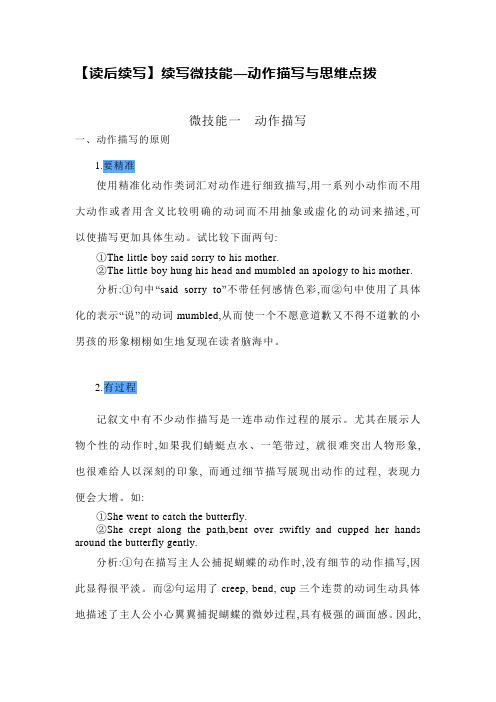
【读后续写】续写微技能—动作描写与思维点拨微技能一动作描写一、动作描写的原则1.要精准使用精准化动作类词汇对动作进行细致描写,用一系列小动作而不用大动作或者用含义比较明确的动词而不用抽象或虚化的动词来描述,可以使描写更加具体生动。
试比较下面两句:①The little boy said sorry to his mother.②The little boy hung his head and mumbled an apology to his mother.分析:①句中“said sorry to”不带任何感情色彩,而②句中使用了具体化的表示“说”的动词mumbled,从而使一个不愿意道歉又不得不道歉的小男孩的形象栩栩如生地复现在读者脑海中。
2.有过程记叙文中有不少动作描写是一连串动作过程的展示。
尤其在展示人物个性的动作时,如果我们蜻蜓点水、一笔带过, 就很难突出人物形象, 也很难给人以深刻的印象, 而通过细节描写展现出动作的过程, 表现力便会大增。
如:①She went to catch the butterfly.②She crept along the path,bent over swiftly and cupped her hands around the butterfly gently.分析:①句在描写主人公捕捉蝴蝶的动作时,没有细节的动作描写,因此显得很平淡。
而②句运用了creep, bend, cup三个连贯的动词生动具体地描述了主人公小心翼翼捕捉蝴蝶的微妙过程,具有极强的画面感。
因此,在续写过程中,在必要的地方恰当使用一连串的动词来表示过程,能为文章增添不少色彩。
3.用修辞除了在动词上做调整, 还可以利用恰当的修辞手法来帮助描写动作。
比喻、拟人、夸张等修辞手法都能让动作描写变得更有表现力。
(1)比喻①The old man’s face wrinkled.②The old man’s face was like a withered apple.(2)拟人①My stomach was aching for not eating on time.②My stomach was punishing me for not eating on time.(3)夸张①When she heard the bad news, she cried.②When she heard the bad news, a river of tears poured out.分析:上面每组中的②句分别使用了比喻、拟人、夸张的修辞手法,使得动作的描述更加生动形象,更加吸引眼球。
续写微技能阶梯训练情景小语段(2)
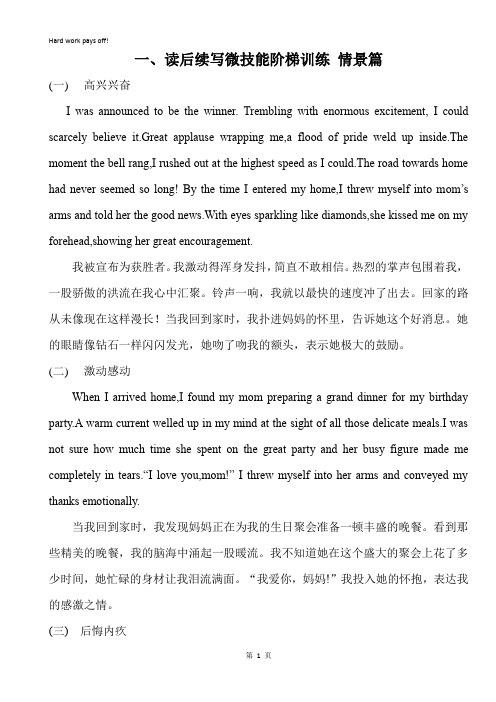
一、读后续写微技能阶梯训练情景篇(一)高兴兴奋I was announced to be the winner. Trembling with enormous excitement, I could scarcely believe it.Great applause wrapping me,a flood of pride weld up inside.The moment the bell rang,I rushed out at the highest speed as I could.The road towards home had never seemed so long! By the time I entered my home,I threw myself into mom’s arms and told her the good news.With eyes sparkling like diamonds,she kissed me on my forehead,showing her great encouragement.我被宣布为获胜者。
我激动得浑身发抖,简直不敢相信。
热烈的掌声包围着我,一股骄傲的洪流在我心中汇聚。
铃声一响,我就以最快的速度冲了出去。
回家的路从未像现在这样漫长!当我回到家时,我扑进妈妈的怀里,告诉她这个好消息。
她的眼睛像钻石一样闪闪发光,她吻了吻我的额头,表示她极大的鼓励。
(二)激动感动When I arrived home,I found my mom preparing a grand dinner for my birthday party.A warm current welled up in my mind at the sight of all those delicate meals.I was not sure how much time she spent on the great party and her busy figure made me completely in tears.“I love you,mom!” I threw myself into her arms and conveyed my thanks emotionally.当我回到家时,我发现妈妈正在为我的生日聚会准备一顿丰盛的晚餐。
[读后续写微技能]读后续写微技能
![[读后续写微技能]读后续写微技能](https://img.taocdn.com/s3/m/e17d9f5c7375a417866f8fb9.png)
浙江英语高考新题型--读后续写不但给学生带来了新的挑战,而且给教师的教学带来了不少的困惑。
2017年虽然已有一届的经历,但教师如何教,学生如何学,仍是当前师生面临的一大课题。
根据《考试说明》,该题主要有以下几个方面的能力要求:1. 理解前文,衔接合理;2. 情节连贯,符合逻辑;3. 正确表达,语言优美。
但笔者认为,这几点要求只是给师生提供了该题的能力要求,或者说是提供了总体的教学目标,但对于平时教学的具体指导与训练,没有多少实质的意义,且所给的范例又少之又少,今年高考甚至都不给范文了。
近来,看到王玉艳编著的《新高考英语读后续写实践指南》一书(—A Practical Guide To English Continuation Writing For The New College Entrance Examination),最有价值的是作者提出了在日常的写作教学中进行“微技能”训练的这一想法,对平时的教学有一定的借鉴作用。
可惜的是,有些实例对于大多数高中生来说实在太难,让人望而生畏。
不过,还是让人看到了努力的方向。
因为读后续写是记叙文为主,所以根据记叙文的特点,可以在以下方面加以积累与训练:1. 时间表达;2. 情感表达;3. 心理活动;4. 动作描写;5. 事件及经过;6. 感悟;7. 可套用的句式。
如2016年浙江新高考《考试说明》英语写作样题,可以让学生在这几个方面去欣赏并模仿。
Paragraph 1: As he was running, Arthur heard the young man shouting (动作) behind, "Stop, stop!" And at that moment (时间), Arthur suddenly (时间) realized (心理) that maybe (心理) the young man was the bank robber. Arthur was a bit frightened (情感), and he continued to rush (动作) until he saw a taxi. He stopped it, jumped in with the suitcase and told (动作) the driver, "Go to thepolice station, please. The man shouting (动作) behind is the bank thief !" The taxi raced away like the wind.Paragraph 2: The taxi stopped in front of the Police Station and Arthur told (动作) the police what had happened. On hearing (时间) his story, the police was determined to(心理) find out the truth about the robbery. They opened the suitcase and to their surprise (情感), they spotted (动作) a large sum of money inside it. Then (时间) the police asked Arthur to describe the young man and the other suitcase. Later (时间), with the information, the police arrested (动作) the robber. The police and the bank both thanked Arthur a lot.那么,如果学生在平时的英语学习过程中,能从以上几个方面加以积累并在写作训练中不断模仿,相信一定会有起到事半功倍的效果。
读后续写和概要写作讲义读后续写高分素材--微技能之细节描写

新高考读后续写高分素材--微技能之细节描写读后续写微技能之细节描写1高考中续写的文体主要为记叙文.顾名思义,记叙文主要以记叙事件为主,因此需要用到许多的细节描写以使文章生动,言之有物.不少学生语言功底不错,但是续写始终得不了高分,其中一个原因可能就是细节描写的缺乏.那么,续写该如何写呢?我们应该做到兼顾概括描述和细节描述,而且要多用细节描述.所谓概括描述是指对一个事件的总体描述,而细节描述那么是对事件的具体描述,来对之前的总体描述进一步解释说明,这样能够使得描述更加生动,有画面感.举例:如表达一个人的疲累时,可用概括描述:she felt exhausted,同时辅以细节描述She felt exhausted and sat by the stream, resting her aching feet.如果大家注意这些细节的描述,一定会为你的记叙文续写增色!“感到害怕〞的细节描述当看到那只凶恶的狼时,我感到很害怕.1、大家可以先尝试用概括描述,先将意思表达清楚.2、请你在此概括描述的根底上增加细节描述,注意逻辑关系以及语意的合理.1)___________________________________2)3)参考答案:1.At the sight of the ferocious wolf, I felt very scared.2. 1)At the sight of the ferocious wolf, I felt so scared that my throat tightened and my knees felt weak.(嗓子发紧, 膝盖发软)2)At the sight of the ferocious wolf, I froze with terror, too scared to move an inch.(P下呆了,不敢动弹)3)At the sight of the ferocious wolf, I was seized by a strong sense of horror and my palms were sweating.(被深深地恐惧感所限制,手心出汗)表感到兴奋thrilled当主持人宣布她获奖时,她兴奋极了.1、大家可以先尝试用概括描述,先将意思表达清楚.2、请你在此概括描述的根底上增加细节描述,注意逻辑关系以及语意的合理.1)___________________________________2)3)参考答案:1)When the host announced that she won the prize, she felt thrilled.2)1) When the host announced that she won the prize, her eyes twinkled with excitement.(冲动得两眼放光)3)When the host announced that she won the prize, her heart was thumping with excitement.(冲动得心砰砰跳)4)When the host announced that she won the prize, a wide excitement took hold of her.(兴奋不能自己)感到悲伤〞的细节描述一听到那个坏消息,她悲伤不已.1、大家可以先尝试用概括描述,先将意思表达清楚.2、请你在此概括描述的根底上增加细节描述,注意逻辑关系以及语意的合理.1)2)3)参考答案:1.Upon hearing the bad news, she felt extremely sad.2.1〕Upon hearing the bad news, her heart ached, tears streaming down her cheeks.〔心痛,眼泪直流〕2〕Upon hearing the bad news, she, numb with grief, had trouble speaking.〔悲伤至U失去知觉,不能开口说话〕3.〕Upon hearing the bad news, she felt seized by a burst of sadness and couldn,t help crying bitterly.被一股悲伤之感限制,忍不住哭泣〕“感到开心〞的细节描述当妈妈亲吻他时,小baby开心极了.1、大家可以先尝试用概括描述,先将意思表达清楚.2、请你在此概括描述的根底上增加细节描述,注意逻辑关系以及语意的合理.1)2)3)参考答案:1.When his mother kissed him on the cheek, the baby was happy/delighted/full ofjoy.1.1)When his mother kissed him on the cheek, it seemed as if the babywere on top of the world.〔非常开心〕2)When the mother kissed the baby on the cheek, his face beamed and his bright smile lit up the room.〔眉开眼笑;笑容照亮房间〕3)When the mother kissed the baby on the cheek, his eyes danced with joy and sweetness.〔欢欣雀跃〕〞感到羞愧〞的细节描述她感到非常羞愧.1、大家可以先尝试用概括描述,先将意思表达清楚.〔答案见底部Key 1〕2、请你在此概括描述的根底上增加细节描述,注意逻辑关系以及语意的合理.1)2)3)〔答案见底部Key 2〕参考答案:Key 1: She felt ashamed.Key 2:1)She felt so ashamed that she could feel her face burning.〔脸上滚烫〕2)So ashamed was she that she could feel the blood rush to her face.〔血液涌上脸颊〕3)So ashamed did she feel that she was close to tears.〔快哭了〕“感到生气〞的细节描述Sheldon感到非常生气.1、大家可以先尝试用概括描述,先将意思表达清楚.2、请你在此概括描述的根底上增加细节描述,注意逻辑关系以及语意的合理.1)2)3)参考答案:Key 1: Sheldon felt very angry.Key 2:1)Sheldon felt so angry that he stormed out of the room, slamming the door furiously behind him.(冲出房间;狠狠摔门)2)Boiling with rage, Sheldon shook his fist at me.(怒火中烧;挥舞拳头)3)Filled with fury, Sheldon was unable to utter a single word.(充满愤怒;说不出话)“感到绝望〞的细节描述Tony感到很绝望.1、大家可以先尝试用概括描述,先将意思表达清楚.2、请你在此概括描述的根底上增加细节描述,注意逻辑关系以及语意的合理.1)____________________________________2)3)参考答案:Key 1: Tony felt hopeless/desperate.Key 2:1)As the result of an accident, Tony was suddenly thrown into a world of darkness and sank into hopelessness.(被投入黑暗之中;陷入绝望)2)Tony felt left out and was getting desperate with loneliness.(感觉被遗忘、无视)3)Tony's beliefs in looking forward and seeing the positive in everythingdeserted him.“人的行走之态〞细节描述1、踉踉跄跄2、悄悄地走3、猛冲〔答案见底部〕Keys:1.The player lost his balance, staggered back and toppled over.这个运发动失去了平衡,向后翘趄摔倒了.2.She slipped out of bed and tiptoed to the window,她溜下床,踮起脚尖走向窗户.3. The minion made a rush for the door and escaped from the scene.小黄人向门冲去,逃离了现场.人的说话方式〞细节描述说话的方式多种多样,如果都用talk就显得索然无味,也不够准确,所以要多积累各种各样的表达.1、说长道短;八卦2、小声咕哝3、嚎叫〔答案见底部〕Keys:1.The whole company is gossiping about the reason for his dismissal.整个公司都在谈论他被免职的原因.2.He murmured against the strict rules of the reality show.他私下低声抱怨真人秀的严苛规那么.3.Treated so unfairly, shehowled in pain and anger,被如此不公正地对待,她痛苦而又愤怒的嚎叫.细节描述之“思考〞如何表达一个人暗自思索时的样子对学生来说是很困难的,大多数情况下,学生往往会选择避开,但是, 人无时无刻不在思考,强行避开会使得故事内容上有些不衔接.所以,今天我们就一起来学习一下如何表达一个人的思考神态.1.得知问题所在之后,他的大脑开始急速运转,想要想出一个好的解决方案.2,单独一人时,他总是会想到那可怕的经历.3.在他洗澡时,忽然想到了一个好主意.〔答案见底部〕Keys:1.After he knew what the problem was, his mind began to race, trying to think of a good solution.〔大脑飞速运转〕2.When left alone, he would always be haunted by that horrible experience.〔[不好的回忆]萦绕心头挥之不去〕3.When he was taking a shower, a brilliant idea suddenlycrossed his mind.〔忽然闪过某人的脑海〕细节描述之“describe a peaceful scene〞今天,我们来看看该如何描述安静祥和的场景.1,享受阳光2,山间有小屋和田地3.入暮时分,芦苇随风飘扬〔答案见底部〕Keys:1.When I was bathed in the sunlight, it felt like the amber-like sunshine was kissing every inch of my skin.〔沐浴在阳光下;琥珀色的阳光亲吻着全身的肌肤〕2.Mist-covered mountains were dotted with small farms and villages.〔点缀着〕3.The sound of my footsteps was accompanied only by the gracefully waving reeds.〔优雅地随风飘扬的芦苇〕细节描述之“describe stormy weather〞今天,我们来看看该如何描述风雨交加的天气.1,乌云密布2.劲风恶浪肆虐3.暴雨疾风〔答案见底部〕Keys:1.The sky is overcast, darkened with gloomy clouds.〔乌云密布;黑云压顶〕2.On that dark and stormy night, the waves were crashing and the winds were howling.〔海浪肆意拍打;劲风咆哮〕3.The rain came pouring down, the streams rose, and the winds blew and beat against the house.〔暴风骤雨〕读后续写对话中的常见误区□1废话连篇,无助推动情节开展,刻画人物性格.“Hey, how are you?〞 “I’m fine, how are you?〞“How is the weather?〞 “Terrific! Nice day for a walk, isn,t it?〞评析:这样的对话在现实生活中很真实,但是小说毕竟是艺术加工,无助情节推动的,不能刻画人物性格的日常应酬和偏离文章主线的对话绝对不用.2追求花哨,过度使用对话标签dialogue tags“That is fantastic news,〞 he said happily.评析:此句中完全没有必要加上一个happily来表达说的方式,由于句中的fantastic 一词足以说明说话人了表情,过度强调dialogue tags会让读者的注意力集中在“说话的方式〞而不是“说话的内容〞.建议改为:“That is fantastic news!〞 he said/screamed/exclaimed.〔一个感慨号和一个fantastic 已经足以让读者想象当时的情景.适当的“艺术留白〞也是需要的,这样会留给读者想象的空间.还有一种防止过度的dialogue tags的方法是运用“动作描写〞来取而代之.如:Her eyes reflected the candlelight as she smiled at her son.“Everyone is unique. Just follow your heart and be yourself!〞3用词不当,错误使用对话标签dialogue tags"I can't believe it," Emma gasped."That's hilarious," Henry chuckled.评析:以上两句话也是我在大量的学生习作甚至是范文中发现的.这里把动作描写和dialogue tags混淆了, 试想谁能gasp 〔喘息〕、chuckle 〔轻笑〕出一句话?除非他或她有特异功能.纠正方法如下:"I can't believe it," Emma said with a gasp.〔Question tag+ with 介词短语〕Emma gasped. "I can't believe it."〔动作描写+句号〕"I can't believe it." Emma gasped.〔对话句断+动作描写〕"That's hilarious!" Henry chuckled.〔感慨句结束+动作描写〕"That's hilarious," Henry said, chuckling.〔Question tag+分词做伴随状况〕请特别关注以上对话的标点.4多此一举,对话对象十清楚确,仍使用对话标签“I told you already,〞 I said, glaring.评析:此句貌似豪华,其实对话中的主语“1〞已经清楚地说明了说话者,完全没有必要用question tag“I said〞来说明说话对象.纠正方法:加上一点动作描写就可以防止这种错误,并且提升语言的生动性.I glared at him. “I told you already.〞5频用副词,词汇贫乏只会tell不会show“How can you do this?〞she said angrily, looking at me furiously.评析:此句也是貌似,高大上〞,使用了大量副词,并且套用了分词做伴随的句型.任何方面都有度,过之而不及.过度堆砌辞藻会让人生厌,过度使用副词也会让阅卷老师觉得你词汇贫乏,非得用副词才能表达出来. 2大纠正方法:1〕积累相关的show的词汇来防止过度使用副词2〕穿插动作描写辅助对话,刻画人物心情试比拟以下两句:“That,s not what you said yesterday,〞 she said, her voice implying she was withdrawing.“That,s not what you said yesterday.〞She hesitated, turned and walked to the window.评析:两句话粗看都是相当不错.无论从词汇和语法结构的使用似乎都属于上乘之作.但细细琢磨下面这句反而更高一筹.原因是,第一句用了imply和withdraw两词来tell说话者she的心情,而第二句hesitate和后面的动作描写让她的犹豫心情跃然纸上.小说故事要的就是这种show的方式.分析对话实例,揭示对话秘诀Example 1原文内容:作者爸爸在阳台种植康乃馨,悉心呵护,作者一家都非常喜欢这些花.爸妈再三强调不允许作者和他姐姐不能触碰这些花.To our surprise, Dad was mad about it, yelling at us, “ Don,t you know touching is not allowed? Wha t on earth have you done?〞赏析:反义疑问句和on earth的使用增强了语气,凸显了父亲的生气.Example 2原文内容:母亲去世,哥哥外出.父女相约吃饭,引发了女儿对母亲和哥哥的思念,父亲读懂了女儿内心的想法,抚慰女儿.母亲在天堂一定希望他们过得快乐,现在他们需要做的就是珍惜身边的人.Seeing this, my father lovingly held my hands and said to me, “Sweetheart, I believe your mother must want you to live happily, so say goodbye to the past and embrace the present. Your brother and I will always be with you.〞赏析:情感类的对话要求感人,触及内心,这点此对话做的不错.但是小编也要对此对话提出点意见1〕文中的and said to me完全没有必要,由于对话对象非常清楚,肯定和我说.2〕your mother显得太疏远,亲人间相互称呼用Mom即可,更显真实,贴近生活.Example 3原文内容:作者家忽然停电,虽然弟弟觉得停电时间非常无聊,但是作者却非常享受停电时间,享受‘没有现代电子科技带来的干扰〞的宁静片刻.Bzzz! The lights return. " Yeah, no more candles!〞 My mother yells, pulling me away from my fantasy.赏析:对话简洁自然,表达了说话者恢复用电时候的兴奋,对话外面的dialogue tag也很出色,分词的使用既丰富了语言也推动了情节的进一步开展.Example 4原文内容:主人公Jenny通过自身的劳动获得了心爱的项链,形影不离.父亲每日给她讲睡前故事.父亲成心试探女儿,问是否可以把项链给他.Jenny深爱爸爸但不舍自己努力得来的项链.A week later, her father once again asked Jenny after her story. “ Jenny, you love me, don,t you? Give me your pearls, okay? “ Daddy, why must you ask for the pearls?〞 Jenny refused again. “ Not only did I finish all those chores, but also I spent the dollar bill given for my birthday just to pay for it.〞They both fell into silence. Then her father smiled, comforting her with a warm hug. “ That,s okey, darling. Goodnight.〞Several days later, when Jenny,s father came in to read her a story as usual, he was surprised to find something under the story book, which turned out to be the necklace. “ Daddy, now you can have it.〞 Jenny raised her head, “ You know, I love you.〞 Her father was moved beyond words. Slowly, he pulled something out of his pocket. It was a pretty necklace with real pearls shining. “The more you are willing to give, the more you are likely to receive. That,s the real meaning of sharing and giving.〞 Her father h elped Jenny put on the necklace . “ You know, I love you, little one.〞赏析:此文运用了大量的对话,主要是考虑到与前文的协同.大量的父女间的对话穿插一些旁白或动作描写很好地刻画了人物之间的冲突,细腻生动地刻画了人物心情.一般的读后续写不建议用太多的对话.适当的对话可以打破单调,推动情节,刻画人物性格.对于此文中的对话,小编也想提出点个人的意见:1) “ Not only did I finish all those chores, but also I spent the dollar bill given for my birthday just to pay for it.〞此匕句似乎为了使用not only…,but also的倒装句型而写对话,显得很不自然.语句太长反而不能表达小女孩当时的生气.建议改为:“It,s mine! My efforts!〞反而显得简洁自然,同样到达了效果,符合人在生气时候的说话方式:短句!不完整句!2)还有一处标点的使用也有误.请看:Jenny raised her head,此处的逗号要改为句号.只能作为动作描写,而不是question tag.Example 5原文内容:这是一个哲理故事,讲述一位商人儿子去向智者寻找快乐秘诀.智者让年轻人带着两汤勺油绕城一周不能将油洒落.智者待年轻人回来后问他是否欣赏到城堡的美景,年轻人哑口无言.然后智者重新让这年轻人带着两勺油绕城一周,结果……“ But where are the two drops of oil I gave you?〞 asked the wise man. Embarrassed again, the young manapolo gized, “ I had forgotten the sp totally. My only concern was the attractive sights.〞 “ But you have got the happiness.〞 Smiled the wise man...“ But where are the two drops of oil I gave you?〞 asked the wise man. He lowered his head and found that there wa s nothing left in his spoon, astonished and embarrassed. Then the wise man smiled generously, “I don't blame you. I just want you to realize the secret of happiness yourself. Now, could you tell me about your thoughts?〞 The young man thought for a while an d slowly replied, “ the truth of happiness is holding our dreams tightly but never failing to watch the beautiful scenery around us.〞赏析:此文的对话主要是用来揭示故事的寓意,通常出现在故事的末尾.这样的对话一定要写出深度厚度, 才能博得老师的高分.建议可以使用强调句.此文中也有一个标点瑕疵.请看:Then the wise man smiled generously,此句的逗号也要改为句号,作为动作描写穿插其中,而不是question tag.他山石可攻玉|这些“恐惧〞情绪的表达你都用过吗?一篇出自美国初中生的看图说话与2021年6月浙江英语高考“读后续写〞酷似!Write a short story based on the pictures below in not less than 100 words.One weekend, my parents decided to bring my brother and I to the recreational jungle. We were very excited as we had not been there before. My brother and I talked about all the bears, tigers and reindeer we were going to see. We really thought that a recreational jungle was like any other jungle.When we arrived, we dashed into the jungle, wanting to explore its length and breadth. We obediently followed our parents at first but found it boring. Just then, a rabbit rushed out. I screamed in delight and ran after it. My brotherfollowed quickly behind. We kept running, always keeping our eyes on the rabbit. The rabbit got tired of running and decided to hide in its burrow.It was only then that we realized that we did not know where we were. The trees looked unfamiliar and there were no more jungle paths for us to follow. We werescared as we realized that we were lost. Night was approaching and the hooting of the owl sent shivers down our spines. I began to cry as I was feeling tired, hungry and sleepy. My brother comforted me by letting me sleep on his lap. I soon fell asleep dreaming of bears waiting to eat me up.Suddenly, I woke up. My brother was shaking me and telling them to get up. We could hear voices coming our way! We shouted with all our might that we were lost. We soon saw beams of light from countless torches. Then we heard our parents' voices. We were safe! My brother and I ran to our parents and embraced them emotionally. We were so happy to see them again that we vowed we never wanted to be separated from them ever again.Notes:burrow: a hole in the ground dug by an animal such as a rabbit, especially to live in send shivers down sb's spines: to make someone feel very frightened vow: to make a determined decisionStudy the following the following examples and learnhow to show one,s fear Example 1 - Fear:Midnight, and someone pounded on the front door. "Mom? Dad?" Where were they? The movie got out at 11. Molly crawled out of bed and tiptoed downstairs. A shadowy figure showed through the frosted glass in the front door. Fear nibbled at her making her knees wobble.Mom's voice echoed inside her head. "Remember, don't answer the door when we're away." Molly crouched, back pressed against the wall, mouth dry-as-dirt. "Please, go away," her words a choked whisper.Key Words - pounded, crawled, tiptoed, shadowy, fear nibbled, wobble, echoed, crouched, pressed, dry-as-dirt, choked. Comments:1〕例1中大量运用了短句,戏剧性的短句能够增强紧张感2〕这些关键字大局部都是强有力且活泼动词.3〕简短的dialogue有效推动了情节开展,营造了栩栩如生的恐惧的场景.It's Your turn:Example 2- Fear:I can feel the sweat drench my skin, the throbbing of my own eyes, the ringing screams vibrating in my ears, and the thumping of my heart against my chest. My fingers are curled into a fist, nails digging into my palm. I can't hear my rapid breathing, but I can feel the oxygen flooding in and out of my lungs. Hesitantly, my eyes look at the dead corpse before me, the person I killed. Fear tortures my guts, churning my stomach in tense cramps. Fear engulfs my conscience, knocking all other thoughts aside. Fear overwhelms my body,making it drastically exhausted. However, most of all, the fear is making me calm and that is what scares me the most.Key words:Your treasure:Example 3- FearTime passed slowly. Cathy stayed hidden within the darkness, feeling every beat of her heart pounding on the cold stone she lay upon. The wine and ale cellar was as quiet as it was dark, with only one sound to be heard; the sound of her own pulse throbbing in her ears. Suddenly, the serenity of silence surrendered to the deathly scream of hinges, as the door opposite her was slowly pried open. A narrow stream of light gracefully meandered through the room, and a shadow quickly followed.She was scared.Cathy held her breathe, daring not to make a sound. Each second seemed to last an eternity as she lay perfectly still listening to the footsteps of the intruder, which had muted the pounding of her pulse.Key words:Your treasure:恐惧来自自身,最大的恐惧其实就是恐惧本身!口读后续写微技能|如何让你笔下的对话更加准确传神对话〔dialogue〕是故事角色在整个故事中对彼此或对自己说的话.它可以用来揭示人物的性格和个性,它也可以用来推动情节向前开展,并展示情节开展的过程.对话是故事中最重要的元素之一.对话的语言要防止冗长的表达,要防止直接告诉读者而要通过其他手段来展示它们.优秀的对话会让你故事中的人物生动立体,栩栩如生,将推动你的故事进展,使其更有乐趣, 而拙劣的对话将破坏一个好的故事.11.如何准确使用对话中的标点请观察下面的句子.Jack asked, “Do you think it will rain today?〞“I have a new umbrella,〞 explained Emily, “and I am excited to try it out.〞“Why don't you check the weather forecast on your phone?〞 suggested Carly.“It is as simple as the smile on your face,〞 he said.先看一个如何使用标点的视频英语对话标点使用规那么:第一、对话提示词〔Dialogue tags〕“Jack asked,〞/ “explained Emily,〞/ “suggested Carly,"的位置可以放在引用的对话前、中、后三个位置.第二、对话中的逗号,永远在引号里面.对话提示词“某某人说〞构成了整个句子的框架,它和它引用的部分是一个整体,是完整的一个句子.这就解释了很多老师的迷惑,为啥对话有时候引用的对话说完了,但是后面却用逗号.如:“It was as hard as a rock,〞 he said. 但是:He said, “It was as hard as a rock.〞第三、整个对话〔引用局部+对话提示词〕完整的时候,才能使用句号.对话开始首字母大写.如果对话提示词是插在一个完整对话中间的,后面需要用逗号.且后半句话开头首字母要小写.如:“I have a new umbrella,"explained Emily, “and I am excited to try it out.〞Exercise 1:给下面的句子加标点1.There's a fifty percent chance of rain this afternoon, reported Emily.2.Emily asked, Do you think I should take my new umbrella to school?3.Of course you should take it to school, answered Jack.4.If it starts raining, Carly added, you will be nice and dry.5.Emily $4优@演〔尖叫〕,I see dark gray storm clouds rolling in.6.Oh no! exclaimed 〔惊叫〕Jack. Carly and I don't have umbrellas.7.Hooray! yelled 〔喊叫〕Emily. It's finally raining.8.Carly mumbled 〔咕哝地说〕,My hair is getting soaked.9.Would you and Jack like to share my umbrella with me? asked Emily.10.Thank you Emily, said Carly. You're more than just a fair weather friend.2如何让你的对话不平庸对话的关注点就是故事中的角色1〕对谁说了什么话2〕说话的同时在做什么3〕如何说的例1A: "Give me the money," Katherine said.B: "Give me the money," Katherine said, eyes staring at the money on thetable o在高考读后续写的实际操作中,我们更加钟爱B这种句式,既说明了说话对象,又描述了说话的方式,让读者更有画面感.例2"Give me that toy gun ," Tom saidangrily.Lucy grinned, hiding it behind her back.这组对话中的said angrily的使用让整个对话表现平庸.改变这种现状的方法有两种I.换直接告诉的词〔said angrily〕为展示型词汇〔如:shouted/ screamed/ barked〕请看下面视频II.在上下文语境明确的情况下,通过动作和神态描写来代替枯燥乏味的sb. said…〔对话提示语〕.这样处理的好处是:1〕增加表现力生动性2〕防止打断对话的语流.如:Tom slammed the doll on the ground and glared at Lucy, "Give me the toy."Lucy grinned, hiding it behind her back..提示:在读后续写的创作中,尽量少用副词来表述说话人讲话方式〔由于你用了副词那就是tell而不是show〕, 特别是你要主要渲染的场景.让你的对话有趣逼真有画面立体感的是你如何使用show的技能,那就一定要使用一些描绘性的动词.〔他们说了什么话,说话时同时在做什么,以及是如何说的〕拙劣表达:"I'm going to the store," Sydney announced happily. "Wanna go with me?"第二个例子中,虽然没有用happily 一词,但是Sydney的快乐的表情是通过动作描写溢于纸面.这样的表达就能博得高考阅卷老师的眼球,从而获得高分.下面的两个例子都是我们需要追求的:“I just don,t know anymore,〞 Mary folded her arms. “I think I,m afraid of you.〞Harry sighed. “I'm sorry,〞He shook his head. “I’m not very good at t his.〞练习2:试比拟体会下面三句话的优劣1.But I don't want to go to sleep yet," hesaid unhappily.2.But I don't want to go to sleep yet," hewhined.3.He stood in the doorway with his hands balled into little fists at his sides. His red, tear -rimmed eyes glared up at his mother. "But I don't want to go to sleep yet."Exercise 3:〔请改写下面的句子使它表达更生动传神〕“I don,t want to see you again,〞 Lily saidtonelessly.“You don,t mean that,〞 Jack saiddesperately.“You're an idiot,〞 Lily saidangrily.对话并不难写.只要记住在任何时候都要生动逼真.在准确的对话格式的前提下,保证你写的所有内容都是展示出来的,不是简单直接地告诉读者在那个场景中发生了什么或者说了什么.省略副词或者不要过度使用副词.这些简单的规那么可以帮助你写出出色的对话.Possible answers for Exercise 3Lily turned away and crossed her arms. “I don,t want to see you again.〞 “You don,t mean that.〞Jack pushed to his feet in a rush.She glared at him. “Y ou,re an idiot.〞读后续写微技能|气氛营造法之一:8大场景描写技能好的读后续写必然要有好的故事气氛.而好的故事气氛要受到多个故事元素的影响:场景、用词选择、对话、独白、语言节奏和修辞法等等.文学中的〔mood〕是一种写作的气氛或普遍基调,它是读者在阅读文本时候的一种情绪体验,也是作者想要给读者营造的一种故事气氛.故事场景是情绪体验的核心因素. 故事的背景和每一个场景的视觉,嗅觉和听觉等其他感官能够营造出一种特定的气氛.今天小编就想从场景描写这个角度来谈谈如何营造〔mood〕.What to write?〔写什么?〕।Where did it take place? When did it happen?Whafs the weather like?What are the social conditions?What is the landscape like? What special details to add?How to write well?〔怎么写?〕Technique 1: Personification 〔拟人〕 Description/purpose:Gives an object the characteristics of a living thing, bringing it to life Examples:The flowers nodded.Snowflakes danced. Thunder grumbled. Fog crept in. The wind howled. The haunted house seemed to stare at me, beckoning me towards the door. Technique 2: simile 〔明喻〕 Description/purpose:Similes likens something to something else giving a more detailed description Examples:The night sky was as dark as the deepest ocean. The stars sparkled like diamonds.The snake moved like a ripple on a pond.Technique 3: metaphor 〔0音喻〕Description/purpose:Metaphors say that something is something else, giving the description more powerExamples:A wave of terror washed over him.Technique 4:Vivid adjectives 生动的形容词〕Description/purpose:To make the story more interesting and vivid by using more imaginative descriptions , sometimes in a list Examples:Gleaming, glistening, whispery flakes of snowTechnique 5: Negative description 〔否认描述〕Description/purpose:To tell the reader what is not there is an effective way of showing how unpleasant, comfortless a place is Examples:There was no cushion, no carpet, no warmth, no light and no comfort.Technique 6: Camera-pan and zoom 〔摄影-全景+放大〕Description/purpose:To use the idea of how a film director works, you can give a wider view then focus in on one detailExamples:From the withering trees he looked past the littered farmyard, across to the decrepit hovel. Its doors hung sadly awry, the handle broken.Technique 7: Nouns for details 〔细节名词〕Description/purpose:Scenes are filled with things that we see and therefore uses lots of nouns, even lists of nouns to convey what is there. Examples:The rooms were crowded with lanterns fastened on oak paneled walls, tableslaid with silver candlesticks and goblets. Technique 8: Senses 〔感官〕Description/purpose:All of our senses become aware in a new situation or place. Your reader needs to know how your character are feeling.Examples:Wafts of salt-laden air were in her nostrils as the skittery sand on her feet led her to the edge of the waves.Good setting description for appreciation 〔佳"景"赏析〕।1.The house smelled musty and damp, and a little sweet, as if it were haunted by the ghosts of long-dead cookies.2.The sun kept dipping down into the ocean and the lights came on at the harbor, casting sudden shadows on the ground, illuminating the faces that were just a second ago silhouettes. The sky was golden and purple, the ocean a darker shade of violet.3.The sun had set, but a faint pastel haze lingered in the mid-summer sky.4.They rolled up the path, tree branches raking the windshield like angry wardens.5.Outside, the air filled with cricket noise, as the sun reddened in its descent.6.A restaurant overlooking a starlit night sprang to my imagination like something out of an illuminated manuscript from the late Middle Ages.7.The moon went slowly down in loveliness; she departed into the depth of the horizon, and long veil-like shadows crept up the sky through which the stars appeared.8.All brightness was gone, leaving nothing. We stepped out of the tent onto nothing. Sledge and tent were there, Estraven stood beside me, but neither he nor I cast any shadow. There was dull light all around, everywhere. When we walked on the crisp snow no shadow showed the footprint. We left no track. Sledge, tent, himself, myself: nothing else at all. No sun, no sky, no horizon, no world.9.Night had fallen fast upon the land. No more than an hour ago the sky was painted with hues of red, orange and pink, but all colour had faded leaving only a matt black canvas with no stars to be looked upon.10.It would be a cold moonless night. The sky was dark and low, the air so chilled it hurt to breathe. Already the ground was laid white with frost and any water that had been liquid under the winter sun had become ice.。
读后续写语言微技能训练

读后续写语言微技能训练随着科技的不断进步,语言微技能训练变得越来越重要,因为人们需要通过语言交流来实现工作和生活中的目标。
语言微技能是指那些小技巧和方法,可以帮助人们更好地表达自己的想法,更好地理解别人的意思。
本文将介绍几种语言微技能训练方法,以帮助读者提高沟通能力。
一、听力技能训练听力技能是沟通的基础,因为只有听懂别人的话,才能做出正确的反应。
听力技能训练的方法有很多,其中最常见的是通过听音频进行训练。
可以通过听新闻、听故事、听电视节目等方式来提高听力技能。
此外,还可以通过模仿别人的语调、语速和音调来加强听力技能。
二、口语技能训练口语技能是实现沟通的关键,因为它可以让人们把自己的想法直接传达给别人。
口语技能训练的方法有很多,其中最常见的是通过模仿别人的发音、语调和语速来提高口语技能。
此外,还可以通过练习口语口音、朗读文章、参加演讲比赛等方式来加强口语技能。
三、阅读技能训练阅读技能是理解别人意思的重要途径,因为很多信息都是通过书面形式传达的。
阅读技能训练的方法有很多,其中最常见的是通过阅读各种文章来提高阅读技能。
可以选择感兴趣的文章、新闻、小说等进行阅读,也可以通过阅读英语原版书籍来提高阅读技能。
四、写作技能训练写作技能是表达自己想法的重要方式,因为它可以让人们将自己的观点和思考表达得更加清晰和准确。
写作技能训练的方法有很多,其中最常见的是通过写日记、写文章、写邮件等方式来提高写作技能。
可以选择感兴趣的话题或者参加写作培训班来提高写作技能。
五、口语交流技巧训练口语交流技巧是实现沟通的关键,因为它可以让人们更加顺畅地表达自己的想法,更加准确地理解别人的意思。
口语交流技巧训练的方法有很多,其中最常见的是通过模仿别人的交流方式、参加英语角、参加辩论比赛等方式来提高口语交流技巧。
语言微技能训练对于提高沟通能力非常重要。
通过听力、口语、阅读、写作以及口语交流技巧的训练,人们可以更好地理解别人的意思,更好地表达自己的想法,实现工作和生活中的目标。
高中英语读后续写与概要写作 微技能四 动作和神情描写
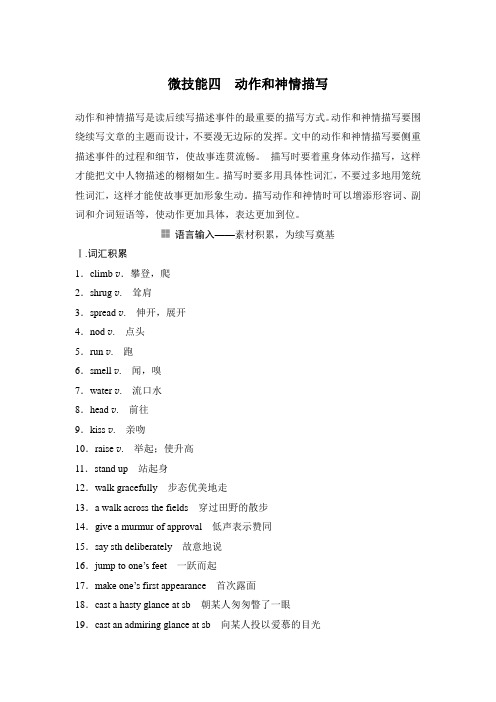
微技能四动作和神情描写动作和神情描写是读后续写描述事件的最重要的描写方式。
动作和神情描写要围绕续写文章的主题而设计,不要漫无边际的发挥。
文中的动作和神情描写要侧重描述事件的过程和细节,使故事连贯流畅。
描写时要着重身体动作描写,这样才能把文中人物描述的栩栩如生。
描写时要多用具体性词汇,不要过多地用笼统性词汇,这样才能使故事更加形象生动。
描写动作和神情时可以增添形容词、副词和介词短语等,使动作更加具体,表达更加到位。
语言输入——素材积累,为续写奠基Ⅰ.词汇积累1.climb v.攀登,爬2.shrug v. 耸肩3.spread v. 伸开,展开4.nod v. 点头5.run v. 跑6.smell v. 闻,嗅7.water v. 流口水8.head v. 前往9.kiss v. 亲吻10.raise v. 举起;使升高11.stand up 站起身12.walk gracefully 步态优美地走13.a walk across the fields 穿过田野的散步14.give a murmur of approval 低声表示赞同15.say sth deliberately 故意地说16.jump to one’s feet 一跃而起17.make one’s first appearance 首次露面18.cast a hasty glance at sb 朝某人匆匆瞥了一眼19.cast an admiring glance at sb 向某人投以爱慕的目光20.gaze up at the stars 凝望着天上的星星21.look at sb with a fixed gaze 凝视着某人22.throw a curious glance at sth 好奇地向某人看了一眼23.hear the thunder rolling in the distance听到远处的隆隆雷声24.praise sb (up)to the skies极力称赞、大肆吹捧某人25.never hear anything against sb从未听说过反对某人的话26.recognize sb at first hearing一听到声音就知道是某人27.break into shouts of applause 爆发出阵阵喝彩声28.listen impatiently 不耐心地听29.pace back and forth 来回踱步30.stroll about/around/through the town 在城里闲逛31.walk across a street 步行穿过马路32.walk arm in arm 臂挽着臂走33.walk through the pouring rain 在倾盆大雨中走34.wander into the woods 漫步向树林里走去35.wander over the countryside 在乡间漫步Ⅱ.佳句背诵1.His head drooped and tears fell into his lap.他耷拉着脑袋,眼泪滴落在大腿上。
[读后续写微技能]读后续写微技能
![[读后续写微技能]读后续写微技能](https://img.taocdn.com/s3/m/e17d9f5c7375a417866f8fb9.png)
浙江英语高考新题型--读后续写不但给学生带来了新的挑战,而且给教师的教学带来了不少的困惑。
2017年虽然已有一届的经历,但教师如何教,学生如何学,仍是当前师生面临的一大课题。
根据《考试说明》,该题主要有以下几个方面的能力要求:1. 理解前文,衔接合理;2. 情节连贯,符合逻辑;3. 正确表达,语言优美。
但笔者认为,这几点要求只是给师生提供了该题的能力要求,或者说是提供了总体的教学目标,但对于平时教学的具体指导与训练,没有多少实质的意义,且所给的范例又少之又少,今年高考甚至都不给范文了。
近来,看到王玉艳编著的《新高考英语读后续写实践指南》一书(—A Practical Guide To English Continuation Writing For The New College Entrance Examination),最有价值的是作者提出了在日常的写作教学中进行“微技能”训练的这一想法,对平时的教学有一定的借鉴作用。
可惜的是,有些实例对于大多数高中生来说实在太难,让人望而生畏。
不过,还是让人看到了努力的方向。
因为读后续写是记叙文为主,所以根据记叙文的特点,可以在以下方面加以积累与训练:1. 时间表达;2. 情感表达;3. 心理活动;4. 动作描写;5. 事件及经过;6. 感悟;7. 可套用的句式。
如2016年浙江新高考《考试说明》英语写作样题,可以让学生在这几个方面去欣赏并模仿。
Paragraph 1: As he was running, Arthur heard the young man shouting (动作) behind, "Stop, stop!" And at that moment (时间), Arthur suddenly (时间) realized (心理) that maybe (心理) the young man was the bank robber. Arthur was a bit frightened (情感), and he continued to rush (动作) until he saw a taxi. He stopped it, jumped in with the suitcase and told (动作) the driver, "Go to thepolice station, please. The man shouting (动作) behind is the bank thief !" The taxi raced away like the wind.Paragraph 2: The taxi stopped in front of the Police Station and Arthur told (动作) the police what had happened. On hearing (时间) his story, the police was determined to(心理) find out the truth about the robbery. They opened the suitcase and to their surprise (情感), they spotted (动作) a large sum of money inside it. Then (时间) the police asked Arthur to describe the young man and the other suitcase. Later (时间), with the information, the police arrested (动作) the robber. The police and the bank both thanked Arthur a lot.那么,如果学生在平时的英语学习过程中,能从以上几个方面加以积累并在写作训练中不断模仿,相信一定会有起到事半功倍的效果。
高考英语读后续写微技能指导—火灾场景描写2

Which is the predicate in the sentence, rage or engulf?
➢ The fires are primarily raging in New South Wales. The sky glows red as bushfires continue to rage.
see, hear, smell, feel, do
Put an adj. before the word “fire”. 大火 the ________________ fire
horrible terrible
violent
猛烈的
ferocious
enormous 巨大的
massive
devastating 毁灭性的
Do the words “rage” in the following sentences have the same
➢ m1Ab1.seumtaSHsilndpdeaaireneiswnegisengwaicvwgihieie,intltAhvefhCiesrueterhhssyePotweorrnaanniimbgtlgeiohaq'euvsnirenlMsfaagiotginintnnoeegeidn.ns?atetetivohhranieges.tnhaafj-ottreeyidsrinnerogeroeghsniiiosdonvefsanJcwtaiaanetluiroeanryin 2. Sue stormed out of the room in a rage. 3. He flies into a rage if you even mention the subject.
FIRE,
高考英语一轮读后续写第二节读后续写微技能

以2022年新高考Ⅰ&Ⅱ卷为例,该材料第二段中提到 关于David 的外貌描写:“He was small for ten years old.”。这个细节我们都可以在续写中再次提及,因为 这样会更加突出David身残志坚的人物形象。如“30
minutes later, I waited anxiously by the finish line as all
第二节 读后续写微技能
一、如何刻画关键人物
一般来说,每个故事都是通过刻画人物性 格、塑造人物形象来表达其主题的。因此,在 把握故事大意后,必须尽快理清故事中出现了 哪些人物、人物的性格特点,以及人物之间的 关系,然后抓住续写中最有可能出现的关键人 物进行刻画。
借助“5W1H工具”得出的故事大意,再结合续写部分 的两段首句,可以很快知道续写中最有可能出现的关键人 物是哪几个。以2023年新课标Ⅰ&Ⅱ卷为例,其所给出的 材料提到的人物有:作者,作者的老师以及作者的姐姐。 而续写部分的两段首句分别是“A few weeks later, when I
2. 以with/without复合结构开头
(2023年新课标Ⅰ&Ⅱ卷) Paragraph 1: A few weeks later, when I almost forgot the contest, there came the news. With an excited expression on his face, my social studies teacher burst into the classroom, holding a piece of paper in his hand.
在刻画人物时,只有把人物的真情实感融入所 叙述的事物当中,这样的人物才会显得真实细腻。 而且,经过情感的包装,即便是纸上的人物,也能 立刻变得鲜活起来。
读后续写三个微技能训练
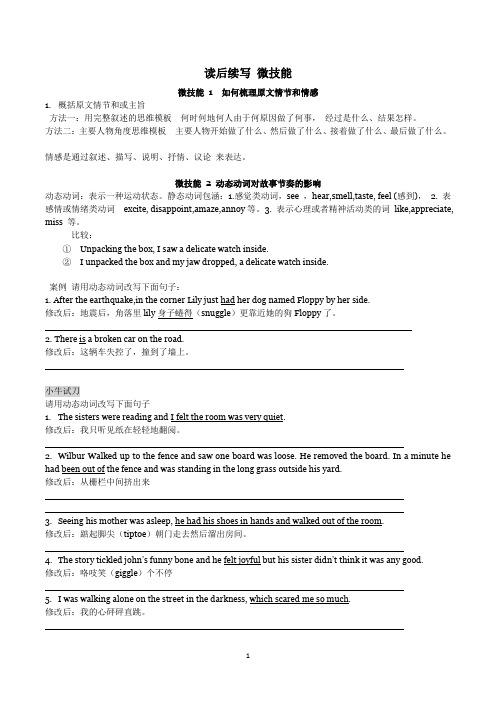
读后续写微技能微技能 1 如何梳理原文情节和情感1.概括原文情节和或主旨方法一:用完整叙述的思维模板何时何地何人由于何原因做了何事,经过是什么、结果怎样。
方法二:主要人物角度思维模板主要人物开始做了什么、然后做了什么、接着做了什么、最后做了什么。
情感是通过叙述、描写、说明、抒情、议论来表达。
微技能 2 动态动词对故事节奏的影响动态动词:表示一种运动状态。
静态动词包涵:1.感觉类动词,see ,hear,smell,taste, feel (感到),2. 表感情或情绪类动词excite, disappoint,amaze,annoy等。
3. 表示心理或者精神活动类的词like,appreciate, miss 等。
比较:①Unpacking the box, I saw a delicate watch inside.②I unpacked the box and my jaw dropped, a delicate watch inside.案例请用动态动词改写下面句子:1.After the earthquake,in the corner Lily just had her dog named Floppy by her side.修改后:地震后,角落里lily身子蜷得(snuggle)更靠近她的狗Floppy了。
2.There is a broken car on the road.修改后:这辆车失控了,撞到了墙上。
小牛试刀请用动态动词改写下面句子1.The sisters were reading and I felt the room was very quiet.修改后:我只听见纸在轻轻地翻阅。
2.Wilbur Walked up to the fence and saw one board was loose. He removed the board. In a minute he had been out of the fence and was standing in the long grass outside his yard.修改后:从栅栏中间挤出来3.Seeing his mother was asleep, he had his shoes in hands and walked out of the room.修改后:踮起脚尖(tiptoe)朝门走去然后溜出房间。
读后续写与概要写作微技能四 动作和神情描写

26.recognize sb at first hearing 一听到声音就知道是某人 27.break into shouts of applause 爆发出阵阵喝彩声 28.listen impatiently 不耐心地听 29.pace back and forth 来回踱步 30.stroll about/around/through the town 在城里闲逛 31.walk across a street 步行穿过马路 32.walk arm in arm 臂挽着臂走 33.walk through the pouring rain 在倾盆大雨中走 34.wander into the woods 漫步向树林里走去 35.wander over the countryside 在乡间漫步
Ⅱ.佳句背诵
1.His head drooped and tears fell into his lap. 他耷拉着脑袋,眼泪滴落在大腿上。
2.He had a slight frown on his face. 他的脸上呈现出有点儿愁眉不展的样子。
3.They walked hand in hand along the path. 他们手拉手沿着小路走。
新高考教案读后续写高分素材微技能之细节描写

适用标准文档新高考读后续写高分素材--微技术之细节描绘读后续写微技术之细节描绘1高考取续写的文体主要为记述文。
顾名思义,记述文主要以记述事件为主,所以需要用到许多的细节描绘以使文章生动,言之有物。
许多学生语言功底不错,可是续写一直得不了高分,此中一个原由可能就是细节描绘的缺少。
那么,续写该怎样写呢?我们应当做到兼备归纳描绘和细节描绘,并且要多用细节描绘。
所谓归纳描绘是指对一个事件的整体描绘,而细节描绘则是对事件的详细描绘,来对以前的总体描绘进一步解说说明,这样能够使得描绘更为生动,有画面感。
举例:如表达一个人的疲累时,可用归纳描绘:shefeltexhausted.同时辅以细节描绘Shefeltexhaustedandsatbythestream,restingherachingfeet.假如大家注意这些细节的描绘,必定会为你的记述文续写添色!“感觉惧怕”的细节描绘当看到那只凶狠的狼时,我感觉很惧怕。
1、大家能够先试试用归纳描绘,先将意思表达清楚。
______________________________________2、请你在此归纳描绘的基础上增添细节描绘,注意逻辑关系以及语意的合理。
1)_______________________________________2)_______________________________________3)_______________________________________参照答案:thesightoftheferociouswolf,Ifeltveryscared.2.1)Atthesightoftheferociouswolf,Ifeltsoscaredthatmythroattightenedandmykneesfelt weak.(嗓子发紧,膝盖发软)2)Atthesightoftheferociouswolf,Ifrozewithterror,tooscaredtomoveaninch.(吓呆了,不敢动弹 )3)Atthesightoftheferociouswolf,Iwasseizedbyastrongsenseofhorrorandmypalmsweresweating.(被深深地惧怕感所控制,手心出汗)表感觉喜悦thrilled当主持人宣告她获奖时,她喜悦极了。
读后续写与概要写作微技能一 利用文体特征 读出有效信息

On the fourth or fifth night,we had trouble finding a hotel with a vacancy.After driving in vain for some time,Mom suddenly got a great idea: Why didn’t we find a house with a likely-looking backyard and ask if we could set up tent there? David and I became nervous.To our great relief , Dad turned down the idea.Mom never could understand our objections.If a strange family showed up on her front doorstep,Mom would have been delighted.She thinks everyone in the world is as nice as she is.We finally found a vacancy in the next town.
4.分析文章的用词特点和行文风格 以便使续写的内容在语言色彩上和行文风格上与所给文章保持一致。
【典例示范】(2017·11月浙江卷改编) 请阅读下面的短文,并归纳出文本信息。
A Vacation with My Mother I had an interesting childhood: It was filled with surprises and amusements,all because of my mother—loving,sweet,yet absent-minded and forgetful.One strange family trip we took when I was eleven tells a lot about her.
读后续写实践技巧分享

读后续写实践技巧分享读后续写是一种将阅读与写作紧密结合的题型,要求考生在阅读给定的文本之后,接着续写一段内容,使之与前文逻辑连贯、情节合理、语言流畅。
这种题型不仅考查考生的阅读理解能力,更考验其写作能力和创新思维。
下面我将为大家分享一些读后续写的实践技巧。
一、仔细研读原文在开始续写之前,一定要对给定的原文进行仔细研读。
理解原文的主题、情节发展、人物性格和关系等方面是至关重要的。
首先,要明确原文的主题。
主题是文章的核心,后续的续写内容必须围绕这个主题展开,不能偏离。
比如,如果原文是关于友谊的主题,那么续写的内容也应该是在友谊这个框架内进行。
其次,关注情节发展。
了解故事已经发生了什么,是为了更好地预测接下来可能会发生的事情。
注意情节中的转折点、冲突和解决方式,这些都可能为后续的写作提供线索。
人物性格和关系也不能忽视。
每个角色都有其独特的性格特点,他们的行为和决策往往会受到性格的影响。
而人物之间的关系,如朋友、家人、敌人等,也会决定他们在故事中的互动方式。
二、合理预测情节在理解原文的基础上,我们要对后续的情节进行合理的预测。
这需要我们发挥想象力,但又不能天马行空,要基于原文的逻辑和走向。
可以从原文的结尾处入手,思考可能的发展方向。
比如,如果原文的结尾是主人公面临一个艰难的抉择,那么续写就可以围绕他做出的选择以及这个选择带来的后果展开。
同时,考虑故事的完整性。
一个好的故事通常有开端、发展、高潮和结局。
在续写时,要注意让情节逐步推进,走向高潮,并最终有一个合理的结局。
另外,设置一些悬念和波折可以增加故事的吸引力。
但要注意把握好度,不能让情节过于复杂或难以理解。
三、塑造生动的人物人物是故事的灵魂,在续写中要继续塑造生动、立体的人物形象。
通过人物的语言、动作、心理描写来展现其性格和情感。
让人物的言行符合其性格特点,比如一个勇敢的人在面对困难时会毫不犹豫地挺身而出,而一个胆小的人可能会犹豫不决。
注意人物的成长和变化。
探究高中英语读后续写微技能培养

探究高中英语读后续写微技能培养
近年来,新一轮的高中英语教学改革的实施,使得英语教学的重点转向了以能力培养为主,而非单纯的知识讲解,而英语读后续写作是实现英语能力培养的一种有效方式。
但是,读后续写在高中英语教学中,究竟如何实施,又能为学生培养何种技能?本文将从以下三方面探究高中英语读后续写微技能培养,即“读、挖掘、延伸”。
首先,教师应该选取对学生比较适合的阅读材料,如小说、故事等,通过讲解,提高学生的阅读理解能力。
在教学过程中,教师要注重学生理解文章及表达能力的提高,逐句指导学生解读句中信息,教会学生挖掘文中鲜明表达及隐含信息,提升学生思维能力及语言表达能力。
其次,教师要在课堂中让学生发挥所学,帮助学生开发自我思维,根据原文挖掘文中的信息,微观的放大文中的重要信息,思考文中的内涵以及文中的故事结局,延伸出新的收获。
例如,假如是一篇故事文章,让学生分析文中的两个角色关系,思考他们的情感以及怎样从文中得到的启示,鼓励学生建构自己的文章,完成书面表达材料的制作等。
最后,教师要定期开展形式多样的文章阅读活动,以及模拟考试。
这样能让学生慢慢熟悉英语文章阅读、理解与口头/书面表达的过程,从而提高各种读后续写英语微技能。
总之,英语读后续写作能有助于学生提高英语读理解能力及表达能力。
把思考、挖掘、延伸融入到英语教学的过程中,让学生在教学
中可以用英语思维来表达自己,更好的练习英语语言能力,达到高中英语教学的目的。
读后续写微技能培养教学设计
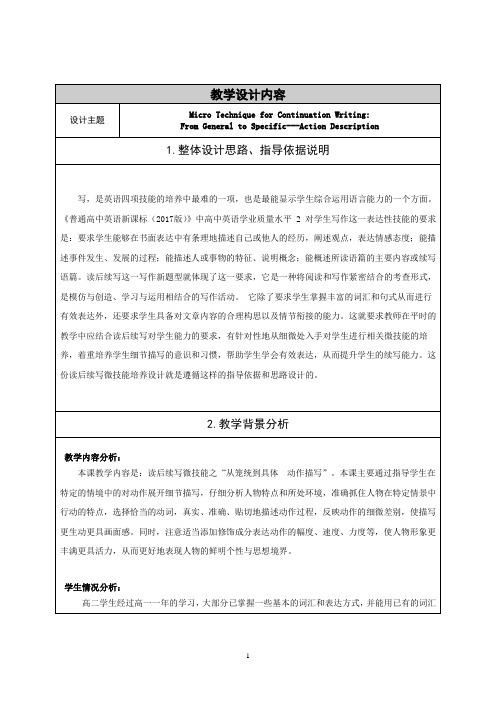
Step 3Learnabout“Show, don’t tell” --- “From General to Specific”(7’)
2.Teacher uses examples to show Ss the difference between telling and showing, leading Ss to pay special attention to the descriptions of actions.
Eg: 1). He is cold. ----telling\ general
教学设计内容
设计主题
Micro Technique for Continuation Writing:
From General to Specific---Action Description
1.整体设计思路、指导依据说明
写,是英语四项技能的培养中最难的一项,也是最能显示学生综合运用语言能力的一个方面。《普通高中英语新课标(2017版)》中高中英语学业质量水平2对学生写作这一表达性技能的要求是:要求学生能够在书面表达中有条理地描述自己或他人的经历,阐述观点,表达情感态度;能描述事件发生、发展的过程;能描述人或事物的特征、说明概念;能概述所读语篇的主要内容或续写语篇。读后续写这一写作新题型就体现了这一要求,它是一种将阅读和写作紧密结合的考查形式,是模仿与创造、学习与运用相结合的写作活动。它除了要求学生掌握丰富的词汇和句式从而进行有效表达外,还要求学生具备对文章内容的合理构思以及情节衔接的能力。这就要求教师在平时的教学中应结合读后续写对学生能力的要求,有针对性地从细微处入手对学生进行相关微技能的培养,着重培养学生细节描写的意识和习惯,帮助学生学会有效表达,从而提升学生的续写能力。这份读后续写微技能培养设计就是遵循这样的指导依据和思路设计的。
读后续写微技巧2

“看”的句子
4. (1) Tina blushed and hastily__l_o_w_e_r_e_d_h__er__e_y_e_s__. 蒂娜脸一红,匆忙垂下了眼睛。
“看”的短语
第2类:“看”的短语
roll one's eyes
scan the room 扫视房间
in a twinkling of an eye 一眨眼, 转眼, 瞬间
look down upon 看不起
look out of the windo 望向窗外
“看”的短语
use accurate verbs
1.小女孩盯着橱窗里的玩具看。
The little girl stared at the toys in the window.
2.吉姆瞪了保尔一眼,但却按住了怒火,一言未发。
Jim glared at Paul, but contained his anger, saying nothing.
3.我们发现有人从窗外向房间里偷窥。
We found someone peeking into the room outside the windows.
Part 2 02
“看”的短语
“看”的短语
第2类:“看”的短语
gaze at
凝视
stare at
凝视
catch a glimpse of sb 看了……一眼
peer over one's shoulder 回头看
gape at sb
目瞪口呆地看着…
- 1、下载文档前请自行甄别文档内容的完整性,平台不提供额外的编辑、内容补充、找答案等附加服务。
- 2、"仅部分预览"的文档,不可在线预览部分如存在完整性等问题,可反馈申请退款(可完整预览的文档不适用该条件!)。
- 3、如文档侵犯您的权益,请联系客服反馈,我们会尽快为您处理(人工客服工作时间:9:00-18:30)。
3) When the mother kissed the baby on the cheek, his face beamed (堆满笑容)and his bright smile lit up the room. (眉开眼笑;笑容照亮房间)
有些许错误,但完全不会影响意义表达。
— 有效地使用了语句间的连接成分,使所续
写短文结构紧凑。
B3 sadness, weep, curiosity, glare, sign, stare, rude, scream, cheer up, terrify, terrified, pleased
B6 melt, bad-tempered, tough, breathless, desperate, disappointed, ashamed, embarrassed, awkward, unconscious, tremble, anxious, anxiety, panic,
读后续写微技能指导2 —人物内心世界(2)
表达的精准性和丰富性
Using adjectives to describe the picture.
happy glad joyful delighte d excited...
sad disappoint ed depressed frustrated upset...
Assignment
1. Polish your story.
She __s_c_ra_t_ch_e_d__h_er_h_e_a_d_, not understanding a word.
ashamed sad……
hang/drop/lower one’s head
他羞愧地低下了头。
He ___h_u_ng_/_d_ro_p_p_e_d_/l_o_w_e_r_ed__h_is_h_e_a_d_____in shame.
angry annoyed cross irritated mad...
surprise d amazed astonish ed shocked ...
读后续写第五档评分原则
档次
描述
— 与所给短文融洽度高,与所提供各段落开
头语衔接合理。
— 内容丰富,应用了5个以上短文中标出的
第五档
关丰富、准确,可能
翻译练习1: Tony感到很绝望。
关于绝望的描写
概括描述Tony felt hopeless/desperate.
1) As the result of an accident, Tony was suddenly
thrown into a world of darkness and sank into hopelessness. (被投入黑暗之中;陷入绝望)
____________________________________________________ ____________________________________________________ ____________________________________________________ ____________________________________________________ ______________________________________
2) Tony felt left out and was getting desperate with loneliness. (感觉被遗忘、忽视)
3) Tony's beliefs in looking forward and seeing the positive in everything deserted him.(被信念抛弃) (主语问题)
2) Filled with angre/fury(狂怒), Sheldon was unable to utter a single word. (充满愤怒;说不出话)
3) Boiling with rage(愤怒), Sheldon shook his fist at me.(怒火中烧;挥舞拳头)
翻译练习2: Sheldon感到非常生气。
关于生气的描写
概括描述Sheldon felt very angry.
1) Sheldon felt so angry that he stormed out of the room, slamming(砰地关上) the door furiously behind him. (冲出房间;狠狠摔门)
Micro-writing
Para. 1: But no more helicopters came and it was dark. How did Jane feel then? How did Jane struggle through the night? Did she fall asleep?
Using actions to describe the feelings
actions
feelings
He covered his mouth to hide his yawn. Our mouths dropped open in surprise. She folded her arms and stared at him. She jumped to her feet at the news. She picked her way carefully along the stream. He paced back and forth. She screamed that there was a snake.
翻译练习3:
关于高兴的描写
当妈妈亲吻他时,小baby开心极了。
概括描述When his mother kissed him on the cheek,
the baby was happy/delighted/full of joy.
1) When his mother kissed him on the cheek, it seemed as if the baby were on top of the world. (非常开心)
tired surprised angry excited cautious upset/uneasy frightened
Can we describe feelings more vividly?
puzzled confused ……
scratch her head [skrætʃ]
她挠了挠头,一个字也听不懂。
